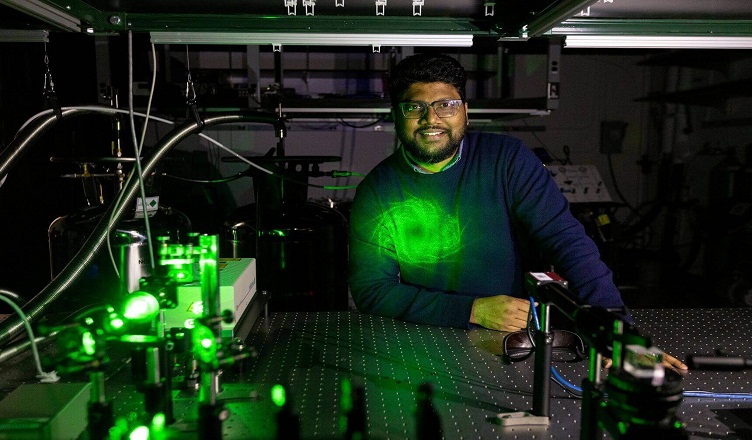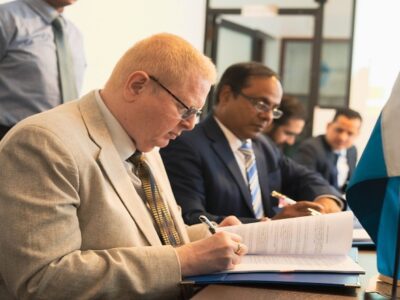(LANKAPUVATH | COLOMBO) –The world’s first superconductor at room temperature, developed by a research team lead by Sri Lankan born physicist, Prof. Ranga Dias at the University of Rochester, USA, could potentially revolutionise everything from transport to energy industry.
The team recently discovered carbonaceous sulphur hydride (CSH), a new compound that acts as a superconductor at 15 °C at a pressure of 267 Giga Pascals (Gpa), or 2.6 million atmospheres (75 percent of the pressure at the earth’s core). The heady article in Nature magazine, which published this groundbreaking discovery in its cover story on October 15, may sound gobbledygook for some. Consequently, The Island interviewed University of Rochester, USA, Department of Physics and Astronomy and Department of Mechanical Engineering, Assistant professor Prof. Ranga Dias; Ph.D. student in Physics, Hiranya Pasan and Ph.D. candidate in Optics, Ashan Ariyawansa to put things in perspective.
Reddmatter shows Room Temperature Superconductivity
Materials that can conduct electric currents without any loss—so-called superconductors—have been wildly impractical because they typically need to be extremely cooled, to around minus 320 degrees Fahrenheit, and subjected to extreme pressure to work.
Now, a group of researchers at the University of Rochester report that they have created a new superconductor that can operate at room temperature and a much lower pressure than previously discovered superconducting materials.
The breakthrough has the potential to create lossless electrical grids, and better and cheaper magnets for use in future nuclear fusion reactors, among other things, according to Ranga Dias, assistant professor of mechanical engineering and physics at the University of Rochester, who led the breakthrough work. That is because perfect conductors that work in everyday, ambient conditions don’t require expensive, large cooling systems.
“We could magnetically levitate trains above superconducting rails, change the way electricity is stored and transferred, and revolutionize medical imaging,” Dr. Dias said.
Room Temperature Superconductivity
Superconductors demonstrate what physicists call the Meissner effect, when a material expels its magnetic field. If you put a superconductor near a magnet, it will levitate, he added.
In 2020, his group reported that they had created a superconductor made up of a hydrogen, sulfur and carbon combination that operated at roughly room temperature. The catch was it only worked after being baked by a laser and crushed between the tips of two diamonds to a pressure greater than that found in the center of the Earth, in a device known as a diamond anvil cell.
For the new study, which was published Wednesday in the journal Nature, the researchers tweaked their superconductor recipe—adding nitrogen and a rare-earth metal known as lutetium to the hydrogen instead of sulfur and carbon—and once again heated and squeezed it in the diamond anvil cell.
They named the resulting material “reddmatter,” after observing how the material’s hue changed from blue to pink to red as it got compressed. The moniker, Dr. Dias said, was inspired by the fictional, black hole-forming substance from the 2009 Hollywood blockbuster ‘Star Trek.’
The Rochester lab found that “reddmatter” could exist at 69 degrees Fahrenheit and 145,000 pounds per square inch, or psi, of pressure—about 1/360th of the pressure in Earth’s core. That is about a 10-degree Fahrenheit increase in temperature and a drop to about 1/1000th of pressure compared with its predecessor from 2020.
“These results are a breakthrough for the scientific community that was enabled by [Dr. Dias’s] keen chemical intuition,” said Stanley Tozer, a research scientist at the National High Magnetic Field Laboratory at Florida State University in Tallahassee, who wasn’t involved in the research.
While still a far cry from the pressure people experience at sea level—which is about 15 psi—the new pressure is within “a range where engineers can jump on and make a commercially viable product,” Dr. Tozer said, adding, “it just makes superconductivity commercially accessible.” Engineers and material scientists can achieve pressures around 145,000 psi using specialized techniques and instruments involved in chip manufacturing and synthesizing diamonds, for instance.
“We will have devices with superconducting components in them in the next five years,” said Ashkan Salamat, a study co-author and physicist at the University of Nevada, Las Vegas. That means our phones and laptops will need less electricity to run, and not lose energy as heat—giving them longer battery life. The same components could be incorporated into electric-car batteries.
A superconductor cooled to an extremely low temperature levitates above magnets in a demonstration at the University of Rochester.
Dr. Salamat said superconductors that work at everyday temperatures and pressures could also help tackle issues like climate change.
“A superconducting grid can store solar or wind energy, for example, for an indefinite period of time and transfer it over large distances without a loss,” he said. The U.S. Energy Information Administration estimated that 5% of electricity, on average, was lost during transmission and distribution in the country between 2017 and 2021. More efficient energy storage and transfer means less energy use overall, which reduces carbon emissions. Superconductors could also pave the way to cheaper, better machines that can conduct nuclear fusion—which has long been seen as a potential source of clean, virtually limitless energy, Dr. Salamat said.
Nuclear fusion reactions, which combine atoms and release a tremendous amount of energy in the process, don’t generate any radioactive waste or greenhouse gases. Many fusion machines rely on magnetic fields to confine the reactions—and superconductors can create some of the strongest fields. The problem is the bulky, expensive cooling apparatuses needed to keep those superconductors cool. Dr. Dias said a superconductor like “reddmatter,” which creates an enormous magnetic field at room temperature, could be a game changer in the next decade or so for efforts to construct fusion reactors.
Noninvasive medical imaging, too, could benefit from superconductors that work at near-ambient conditions, Dr. Salamat said. Most magnetic resonance imaging, or MRI, machines rely on superconducting magnets, which are made by passing an electrical current through coils of superconducting wire, creating a magnetic field. Those coils are chilled using liquid helium—a scarce and expensive resource that limits where MRI systems can be housed, Dr. Salamat said. A room-temperature superconductor could enable smaller, more portable MRI machines that don’t need to be kept cool.
“Now, these are very big engineering feats and won’t happen tomorrow. But these are coming in the next decade or so as a consequence of this discovery and others like it,” he said.
While Dr. Dias’s research shows promise, some of his group’s past work has been a target of scrutiny by other scientists. Their 2020 study, detailing another room temperature superconductor, was retracted by Nature last year after other researchers were unable to replicate the results and questioned the validity of the data showing the Meissner effect in the material.
Dirk van der Marel, a University of Geneva physicist who wasn’t involved in the new research or Dr. Dias’s other work, was among those who raised issues about the 2020 data.
Dr. Dias said the retracted paper has been resubmitted to Nature after he and his colleagues collected new data in front of other scientists at the Argonne and Brookhaven National Laboratories, in Illinois and New York, respectively. He added that his group made all their data around “reddmatter” available during the peer-review process for the new paper.
Although Dr. van der Marel said the new study appeared to properly demonstrate the effect in “reddmatter,” he said he feels “extremely uncomfortable about the whole thing.”
“Similar issues could lurk” in the data, he added.
The idea that superconductivity is achievable at room temperature with materials rich in hydrogen has been corroborated by other groups, said Russell Hemley, a professor of physics and chemistry at the University of Illinois Chicago, who wasn’t involved in the new research but has collaborated with Dr. Dias on other projects.
“So these results shouldn’t be in doubt, even if there were concerns about some of the way in which the data has been presented in their earlier paper.” Dr. Hemley said.
For his part, Dr. Dias said his group is already looking to tweaking their “reddmatter” recipe to try to achieve superconductivity at even warmer temperatures and lower pressures.
Graduate students work on creating and analyzing new superconducting materials in one of Dr. Dias’s labs at the University of Rochester.
One idea is throwing other rare-earth elements that are similar to lutetium into the mix, though these rare elements are expensive, Dr. Dias said. He hopes to try a different approach—maybe aluminum with a dash of something else—which is cheaper to make and can mimic lutetium’s effects.
The group will start using machine-learning to select their next superconductor recipes. They are training algorithms with data from this new work and previous experiments to help the AI better predict what combinations of hydrogen and other elements may yield superconducting materials.
“It is remarkable that Mother Nature allows us to use different pathways to get to these remarkable superconducting states,” Dr. Salamat said, who added that dropping the pressure down to zero is the group’s next goal.
Dr. Dias said he’s confident that achievement is coming: “It is just a matter of time.”




